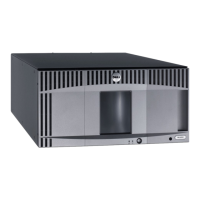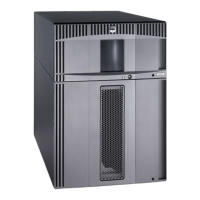Configuring Your Library
file:///T|/htdocs/stor-sys/ML6000/en/html/ch04.htm[9/17/2012 1:49:29 PM]
For each available partition and tape drive, the screen lists the following:
• Description — For tape drives: Drive [location coordinates][(associated partition)]. For partitions: the name
assigned to the partition during the partition creation process.
• Type — Device type, for example, processor, medium changer (partition), tape drive.
• Serial Number — Serial number of the partition or tape drive.
• Vendor — Device manufacturer.
• Product — Name of the device.
• LUN — Current logical unit number (LUN) assignment. Assign a new LUN number for the device.
Note: The operator panel host mapping configuration screens show less information about each device;
however, you still select the host and device(s) and configure the LUN number(s(.)
• After configuring FC host mapping, save the library configuration. For instructions on how to save the library
configuration, see
Saving and Restoring the Library Configuration.
Note: A warning message will display if the command and control LUN (CCL) or another device is not mapped to LUN
0 (zero). LUN 0 is typically occupied by the command and control LUN (CCL), unless it has been manually mapped to
another LUN. Make sure at least one device is mapped to LUN 0.
Note: If an FC switch is attached to an I/O blade target port, the FC switch will appear in the Blade Host Management
list as if it were an FC host. Do not map library devices to an FC switch. To avoid confusion, it is recommended that
you modify the FC switch host name and type using Blade Host Management. See
Modifying an FC Host Connection.
Note: If both channel zoning and host mapping are enabled, the channel zoning settings supersede any host LUN
mapping on the I/O blade. For information on channel zoning, see Configuring FC I/O Blade Channel Zoning.
The paths to open the appropriate screens are as follows:
• From the operator panel, select Setup > I/O Blades > Host Mapping.
• From the Web client, select Setup > I/O Blades > Host Mapping.
Configuring FC Host Port Failover
When I/O blades are installed in the library, administrators can enable and configure the optional FC host port failover feature.
This feature is disabled by default.
You can configure the FC host port failover feature so that a "standby" target port (1 or 2) on an I/O blade can assume the
identity and LUN mapping configuration of the designated "active" target port if the active port fails. Host port failover enables
the library to continue operations without requiring you to reconfigure the host or the SAN.
To enable host port failover, you must configure target ports 1 and 2 on the I/O blade as point-to-point connections (Setup >
I/O Blades > Port Configuration). I/O blade target ports 1 and 2 must be attached to the same SAN fabric to provide host
access. The primary active port is used for host communications, while the passive standby port is kept idle. In addition,
channel zoning must be configured so that target ports 1 and 2 have access to all initiator ports (ports 3–6) (Setup > I/O
Blades > Channel Zoning). If these conditions are not met, an error message will display when you attempt to enable host
port failover.
Note: The current feature implementation does not support arbitrated loop or target/initiator mode.
Note: Ports on the 4 Gb FC I/O blade used for failover must connect to the same SAN fabric.
Note: When both target ports on the I/O blade are attached to the same SAN fabric, you may see duplicate medium
changers being reported. To stop this from happening, you need to enable host port mapping and configure host
mapping. For more information, see
Configuring Host Mapping.
For information on configuring I/O blade ports and channel zoning, see Configuring FC I/O Blade Ports and Configuring FC I/O
Blade Channel Zoning.
The library generates a Reliability, Availability, and Serviceability (RAS) ticket when port failover occurs. Examine the ticket to
determine the reason for the failover. When the failed port is repaired, the port must be re-enabled to make it available for

